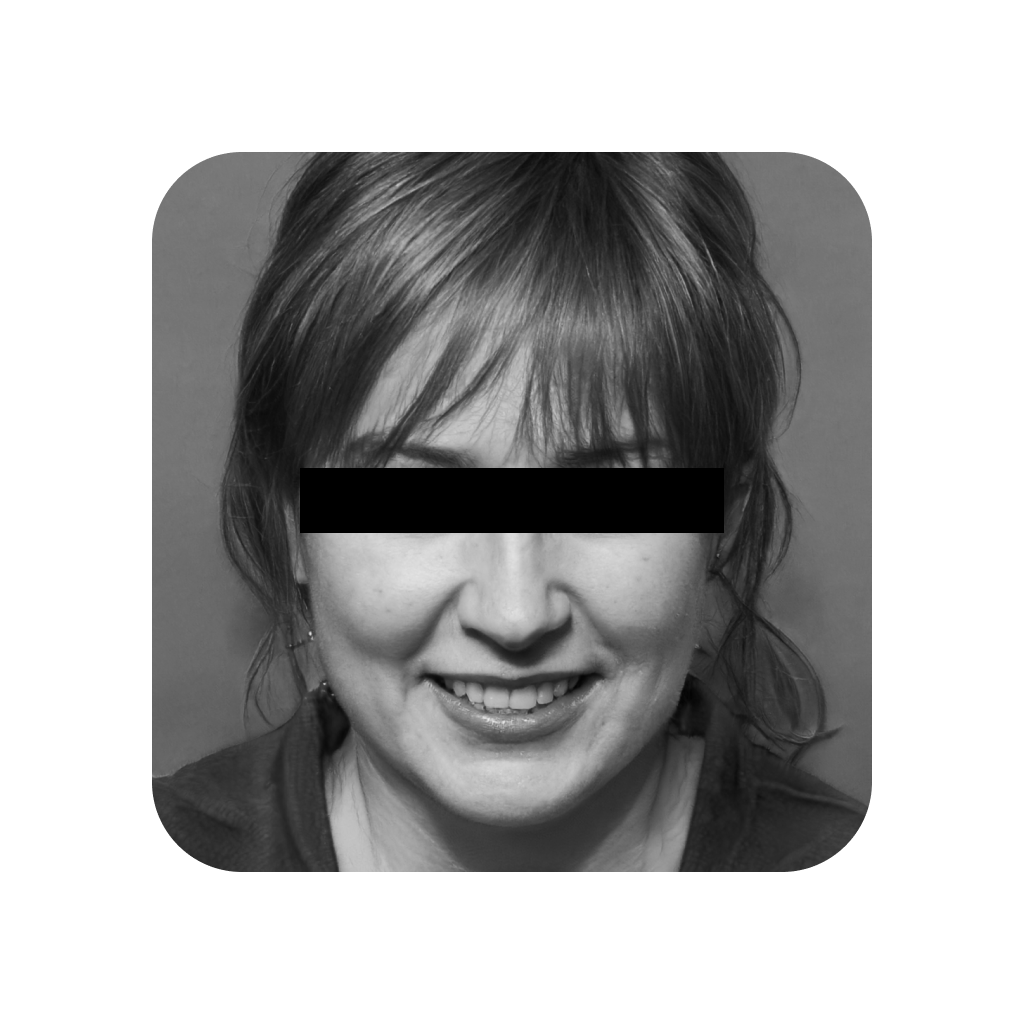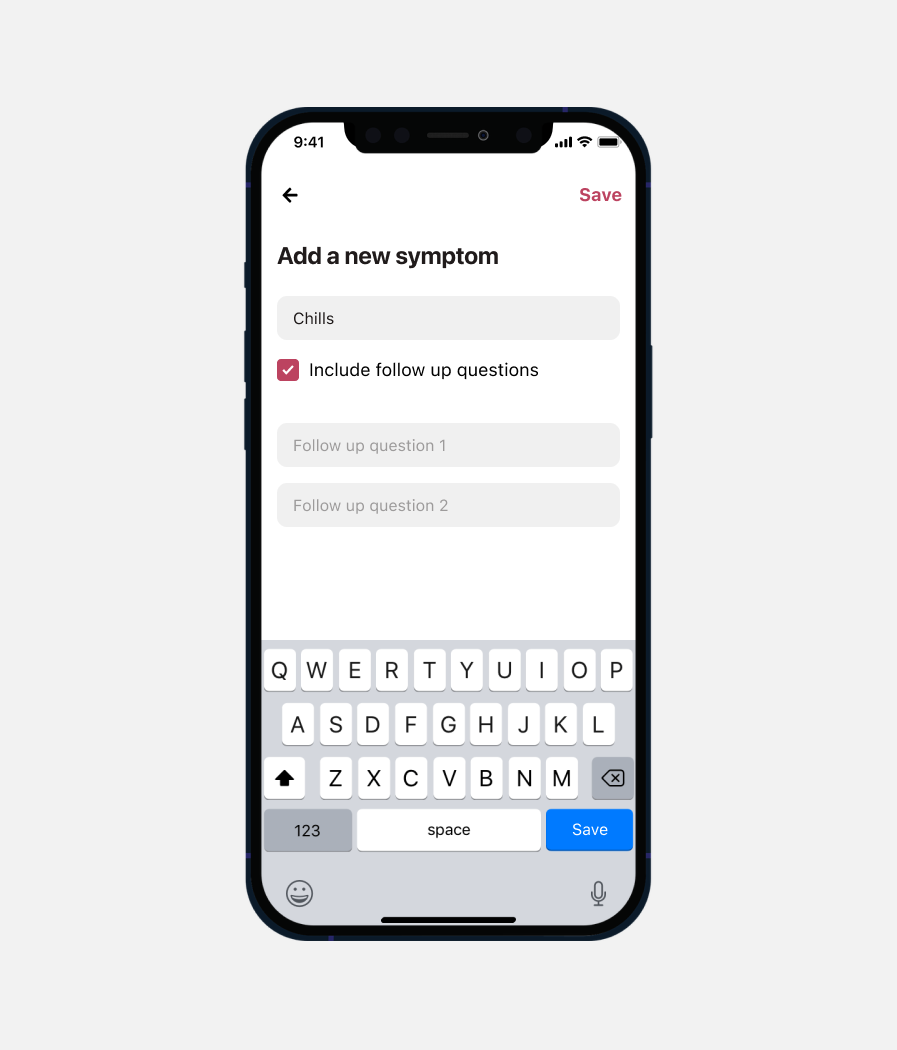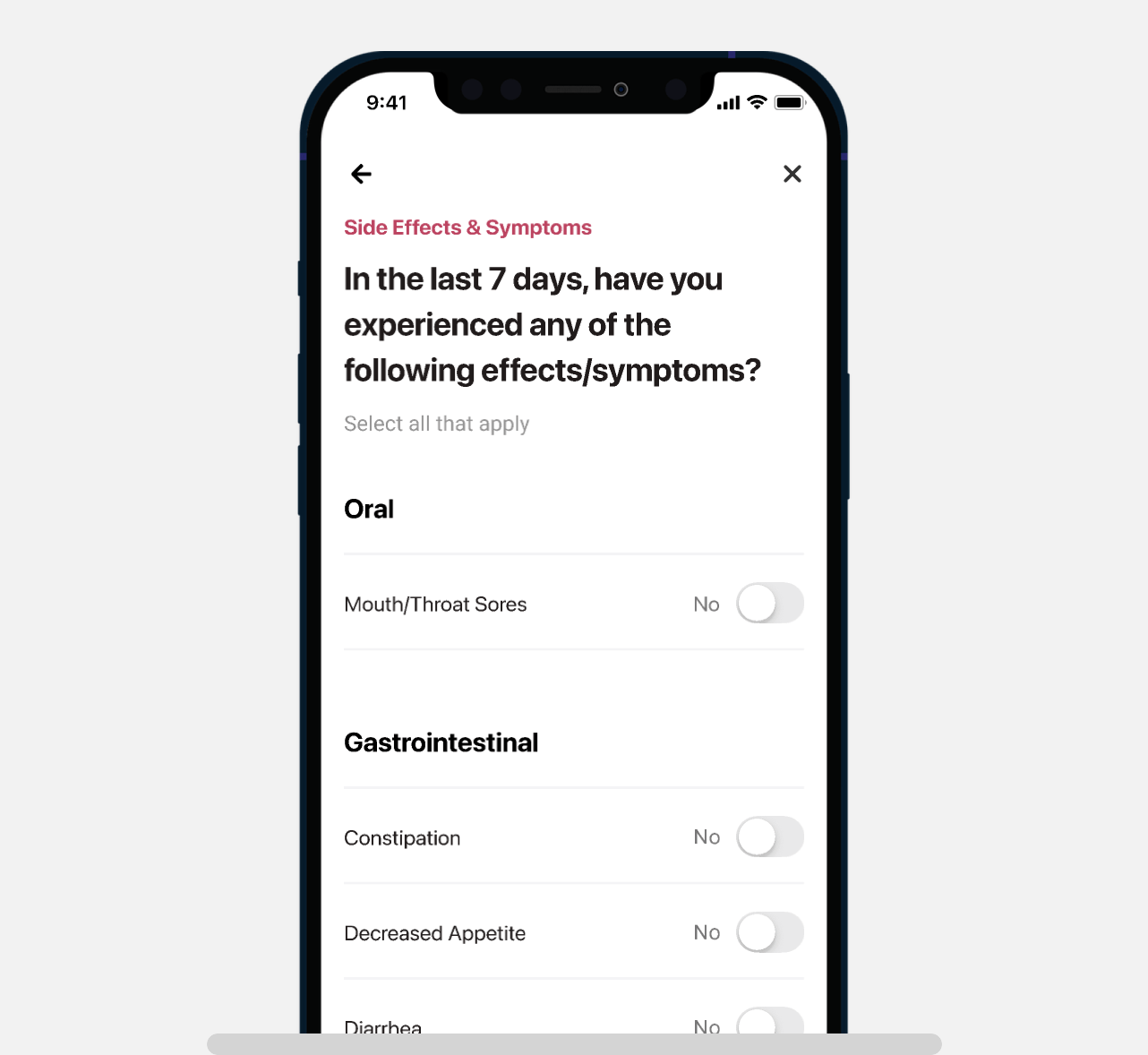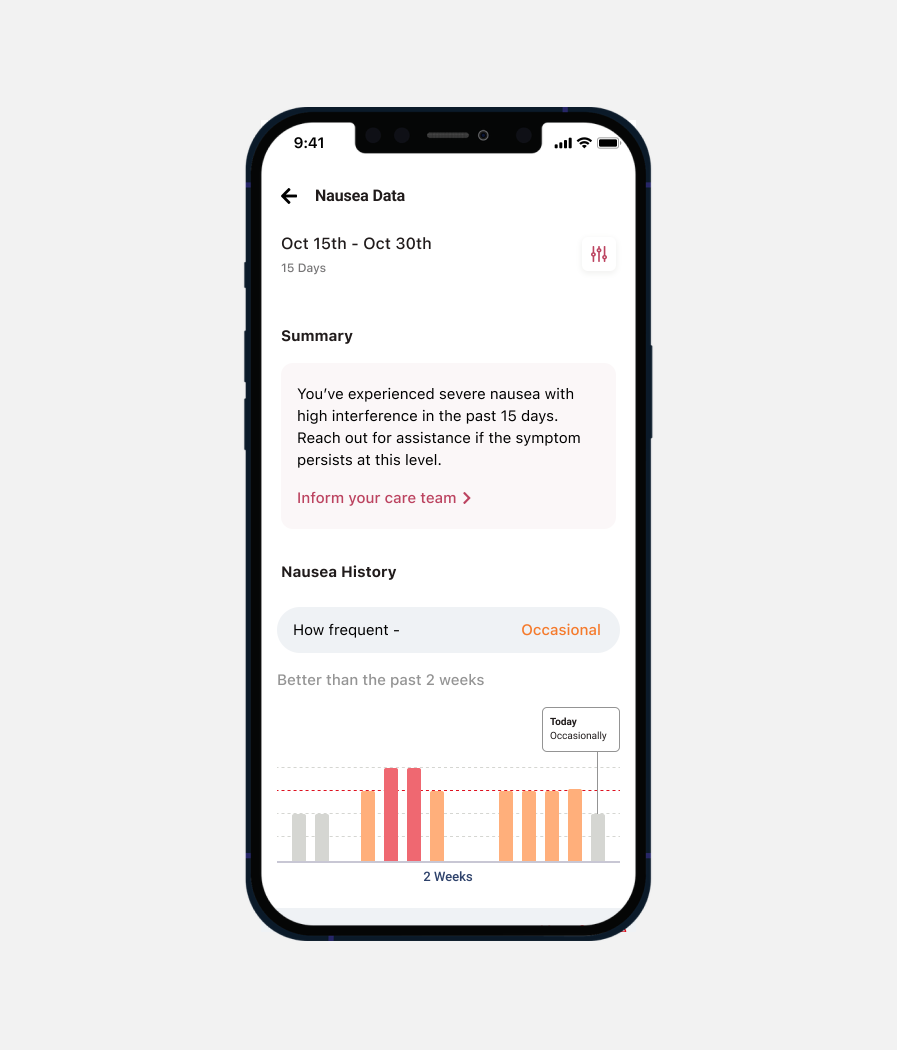
overview/TLDR
This project was for a reputable healthcare company and their vision of aiding breast cancer patients through their treatment/recovery.
The app, specifically designed for breast cancer patients/survivors provides a comprehensive platform for patients to track and monitor their treatment and/or post-treatment journey, all in one place.
At its core, it offers two primary surveys that patients can use to monitor their progress. The first survey focuses on tracking physical symptoms, such as pain, fatigue, and nausea, while the second survey is designed to evaluate emotional well-being, including mood, stress levels, and support network.
Elise is designed to make the treatment journey easier and less stressful for patients. With its user-friendly interface, patients can easily log their symptoms and moods and see how they change over time. This information can also be shared with healthcare providers, giving them valuable insight into a patient's progress and helping to inform future treatment decisions.
In addition to the surveys, it also includes 2 individual dashboards to track the aforementioned surveys + a wealth of educational resources and support materials - including articles, videos, and forums where patients can connect with others going through similar experiences. With Elise, patients can feel empowered to take control of their treatment journey and receive the support they need to stay positive and motivated.

outcomes & learnings
Apart from managing a team of designers and working collaboratively across continents, working on a healthcare app dedicated to such a unique user group was a profound experience.
Here are some of the key takeaways I've gained:
- User Empathy: This project deepened my empathy for individuals dealing with cancer, helping me prioritize user-centered design and sensitivity to their unique needs in my future work.
- Data Visualization: Learning to create clear and meaningful graphs and charts to represent medical data effectively.
- Privacy and Security: Handling sensitive patient data underscored the significance of privacy and security considerations
- User Testing and Feedback: Testing with cancer patients emphasized the value of user feedback.
- Simplicity and Clarity: Healthcare apps demand simplicity and clarity in design.
Kindly contact me for more information :)
team structure
My team consisted of one consultant designer and two analyst designers. I collaborated closely with the functional and development leads to ensure efficient delivery of work, while also managing client-facing operations.
Throughout the design delivery process, I collaborated closely with functional and development leads. We held regular brainstorming sessions to discuss design feasibility and technical considerations, ensuring that the final design solutions met both user needs and technical requirements.
Additionally, I facilitated design review meetings with key stakeholders to gather feedback and iterate on designs accordingly. I provided design specifications and assets to the development team, working closely with them to address any implementation challenges and ensure accurate translation of design concepts into the final product.
understanding the need
//research stratagem

Since the user base was very unique, we wanted to make sure we were sensitive to their challenges while designing the platform.
Before developing the app, extensive research was conducted to better understand the breast cancer patient journey.
Researchers spoke with ~40+ breast cancer patients and survivors, as well as healthcare providers, to gather firsthand accounts of the challenges/ obstacles (e.g. who is their primary caretaker, how do they administer their treatments, their frequency etc.)
our personas

Aria, 32
Marketing professional who was recently diagnosed with breast cancer. Sarah is feeling anxious about the diagnosis and all of the treatments she will have to undergo.
She is looking for a way to track her symptoms and moods so that she can better understand how her body is responding to the treatments.
Sarah is tech-savvy and is looking for a solution that is easy to use and visually appealing. She wants to be able to access the app on-the-go and share her progress with her loved ones.

Danielle, 55
Retired teacher who was diagnosed with breast cancer several years ago. Dani is a proud survivor, but she still experiences physical and emotional symptoms related to her treatment.
She is looking for a way to stay on top of his symptoms and moods and to share this information with his healthcare team.
Dani is tech-savvy, but is looking for a solution that is simple and straightforward to use.

Janet, 42
Stay-at-home mom who was recently diagnosed with breast cancer.
Janet is feeling overwhelmed by the diagnosis and all of the treatments she will have to undergo. She is looking for a way to keep track of her symptoms and moods so that she can better understand how her body is responding to the treatments.
Janet is a technology-savvy individual and is eager to find a solution that is easy to use and accessible on-the-go.
home screen
The home screen of Elise is designed with the user in mind, offering a clear and intuitive interface that makes it easy for patients to track their treatment journey. The home screen features two prominent buttons that lead to the primary surveys, allowing patients to quickly and easily log their physical symptoms and emotional well-being.

Patients can also view a calendar that shows their treatment schedule and a graph that displays their symptoms and moods over time. In addition to the surveys and calendar, the home screen features quick links to educational resources, support materials, and the Elise community, providing patients with a comprehensive solution to their treatment journey. The home screen is designed to be user-friendly, visually appealing, and easy to navigate, making it the ideal starting point for patients looking to track their treatment journey.
survey I — symptom tracker
Symptom tracker's primary goal was to help patients track their physical symptoms related to their treatment. It was designed to be simple, straightforward, and easy to use, making it a valuable tool for patients while navigating their treatment journey.
The primary 3 sections of the symptom survey is as follows:
- General and Physical Pulse check
- Symptom list and follow up questions
- Add your own symptoms


general/physical pulse check
This segment of the symptom tracker deals with getting an overview of the patient's condition.
Consisting of broad questions like "How have you physically/mentally/emotionally felt in the last 7 days?" It sets up a benchmark of data to send to the patients care team before delving into more detailed questions regarding their day-to-day symptoms.
symptoms and follow-up questions
Once the patient has answered the preliminary questions, they are greeted by an indepth yet simple questionnaire which asks them to mark which symptoms they have been experiencing of late.
To make navigation easier, the symptoms are grouped, categorized, and marked with toggle buttons set to "No" by default. Activating a symptom toggle prompts tailored follow-up questions crafted by medical professionals, addressing severity, frequency, and daily impact on patients' lives.

adding custom symptoms
Additionally, the survey empowers patients with the flexibility to add custom symptoms, acknowledging the unique aspects of their journey. This feature ensures a comprehensive and personalized symptom-tracking experience, allowing users to inclusively monitor their health and well-being.
This information is then packaged and sent to their care team to aid them.
survey II — wellness check
The wellness survey uses a point-based scale, ranging from 0 to 4, to assess the intensity and frequency of various emotional and mental aspects. This allows patients to provide a more nuanced and accurate assessment of their mental and emotional well-being, giving healthcare providers a more complete picture of their progress.
This is done through presenting them with directed statements like "I have a lack of energy" or "I have trouble meeting the needs of my family"
This information is then used to provide personalized feedback and support, helping patients manage their mental and emotional symptoms and feel more in control of their treatment journey. The use of a point-based scale provides a more accurate and comprehensive assessment of a patient's emotional well-being and is an essential tool for managing the mental and emotional challenges associated with a breast cancer diagnosis.

patients dashboards
The dashboards prominently feature a summary of key data, such as recent symptom trends, their severity, and any notable changes over time. Users can visualize their symptom history through intuitive graphs, offering insights into their health trajectory.
Additionally, the dashboards provide quick access to personalized recommendations and educational resources, ensuring patients have the information they need at their fingertips. A customizable calendar feature allows users to schedule medical appointments, set medication reminders, and track treatment milestones conveniently.
Overall, the dashboard aims to empower breast cancer patients with a holistic view of their health status while fostering a sense of community and empowerment throughout their journey.
impact
Elise has made a significant impact, with users reporting increased empowerment and control over their treatment journey, reduced symptom severity, and improved emotional well-being. Healthcare providers have also benefited from the app's data-sharing feature, leading to more informed treatment decisions and increased efficiency in clinical practice.
- 68%* Users reported feeling more in control of their treatment journey
- 20%* Increase in daily engagement compared to similar healthcare apps
- 1,132* No. of times the educational resources were accessed over a month
- 12%* Decrease in symptom severity after tracking for a month
*All data represented here is skewed for legal protection reasons
Want to know more?
Get in touch →
Bengaluru, India
Phone: +91 836 0183 960
Email: [email protected]
Created on Semplice © Atish Ray 2024





